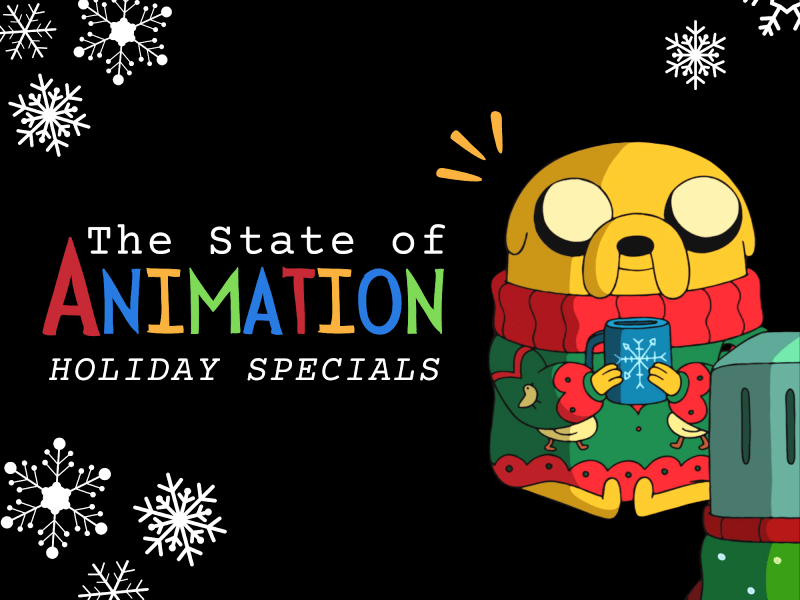Welcome to “The State of Animation,” a column about the wonderful world of cartoons. Animation isn’t just for kids; it’s a medium that allows for ample creativity and continues to grow in popularity. From groundbreaking animated movies to dark cartoon comedies, I’ll be showing you a bit of everything. I’m Kristofer Nino, a lifelong fan of animation here to help you find your next animated show to binge and to prove that cartoons are for everyone.
As we approach winter, lovers of cartoons are at once bombarded with the strange, but festive tradition of holiday specials. So many of my favorite animated shows have managed to include a special episode dedicated to Christmas, no matter how unusual it would be to shove the holiday into their animated worlds. When shows like “Adventure Time,” “Dora the Explorer” and even “Bojack Horseman” feature a holiday special, it seems that no show can escape the holly-jolly spirit. But why do so many cartoons dedicate an entire special to the winter holidays?
To be clear, when I use the term “holiday” or “Christmas special,” I’m referring to the phenomenon of television shows having episodes that are set around Christmas or prominently feature holiday themes. While there are plenty of nostalgic holiday specials not connected to a specific show — such as “Rudolph the Red-Nosed Reindeer” or “The Nightmare Before Christmas”— they are not the main focus of my inquiry, since they are made specifically for the holidays. Why do established shows need to interrupt their own continuity just to include a holiday episode?
On one hand, it is easy to see the connection between Christmas and cartoons. Cartoons are colorful conglomerations of whimsical elements and characters designed to entice younger audiences. So many American traditions around Christmas time are associated with wondrous childhood activities: wishing for toys from Santa, baking sweet cookies and building snowmen in the yard. It makes sense that television catering to children would want to use the playful atmosphere of the holidays as a setting for their own characters.
Yet, as I mentioned earlier, it isn’t just kids’ cartoons that have holiday specials. Even “Bojack Horseman” or “Rick and Morty” have time to let the spirit of St. Nicholas into their adult-oriented shows, albeit with their own nihilistic flair. Perhaps Christmas is so important to American culture that no animated adventure can escape its orbit.
Furthermore, specials rarely ever feature holidays such as Hanukkah or Kwanzaa. This may be tied to how generalized Christmas iconography has become in Americana. While the holiday is undeniably tied to Christianity, many non-religious Americans still celebrate Christmas. Characters like Santa Claus or Frosty the Snowman have become mascots that are more closely associated with ideas of whimsy and vague American folklore, rather than any specific church, helping Christmas to easily fit into any child’s favorite cartoon.
The cynic in me can’t overlook the commercial side of this innocent trend. For many, Christmas is the most profitable time of year — maybe Christmas specials are just another way of reminding kids which character’s action figures they “need” to buy this year, teaching even the youngest to be part of the consumerist conveyor belt.
On a narrative level, holiday specials often act as filler episodes, detracting from the main plot rather than building upon it. Disney’s “Phineas and Ferb” is a show known for being set within “a hundred and four days of summer vacation,” however, the show’s 2009 Christmas special takes place during winter break, completely detached from the continuity of the rest of the iconic cartoon. And for a show that is so creative with subverting cartoon formulas, the episode feels stale (except for some undeniably catchy music).
Yet despite these problems, I can’t remain a Scrooge in the face of the comfort these specials have brought me. Even though the narratives can feel forced, I remember feeling a pure sense of warmth watching these specials as a child. Seeing characters pause their usual adventures to exchange gifts or decorate their homes is oddly satisfying, reminiscent of how we as children would leave our own “adventures” at school and return home for winter break.
One particular favorite Christmas episode of mine is from “Adventure Time,” entitled “Holly Jolly Secrets” (2011). On the surface, this episode seems just as silly as any other in the absurdist cartoon series: The show’s protagonists, Finn the Human and Jake the Dog, are snowed in by a blizzard created by their nemesis, the Ice King. The heroes watch the villain’s old VHS diaries, bundled up in ugly sweaters and sipping hot chocolate.
Yet, as the special goes on, the heroes discover the Ice King’s tragic backstory. While I don’t want to reveal too much about what exactly happens, the episode ends with a touching moment of empathy. After learning this startling truth about their nemesis, Finn and Jake put aside their differences and let Ice King join them in enjoying the snow day. Despite specials usually being “filler,” this one stands out as one that didn’t sacrifice narrative for the festive aesthetic.
Holiday specials are a strange tradition in television. But perhaps through the familiar tropes in these specials, we can find peace and awe. When you find yourself feeling hopeless during finals season or winter break, I encourage you to grab a blanket and your remote, then find the holiday special of your favorite childhood cartoon. Let yourself enjoy the memories of the simpler times and of a repetitive, yet comforting narrative.
Editor’s Note: This article is a review and contains subjective opinions, thoughts and critiques.
